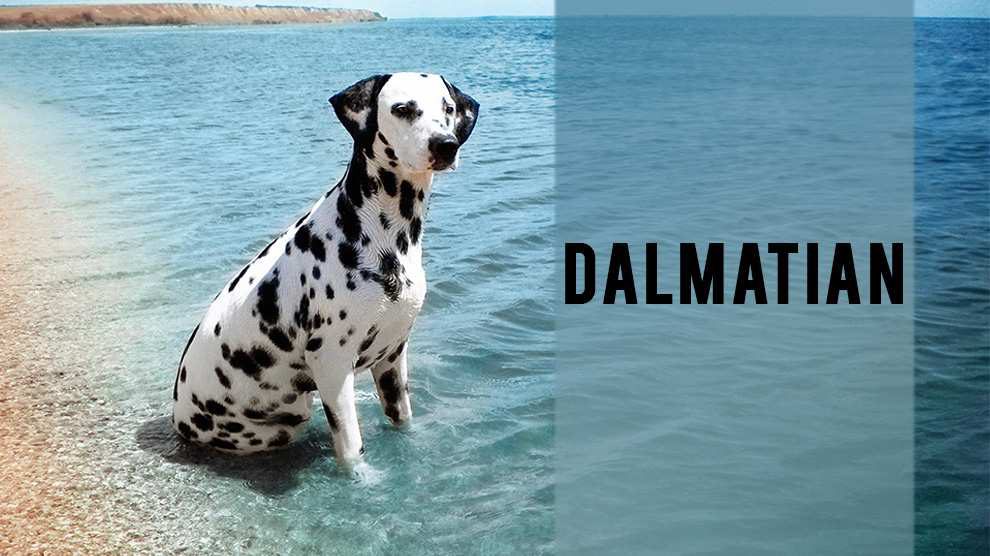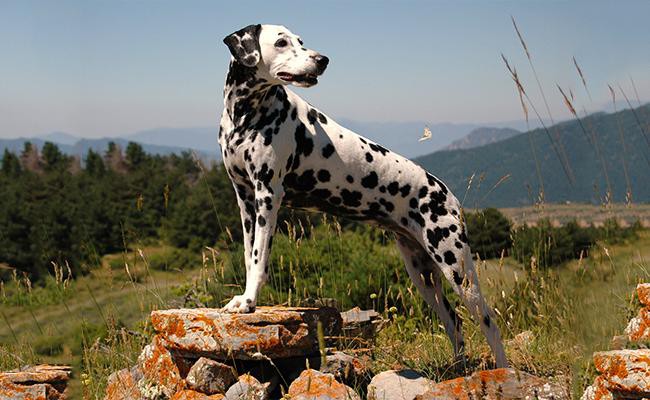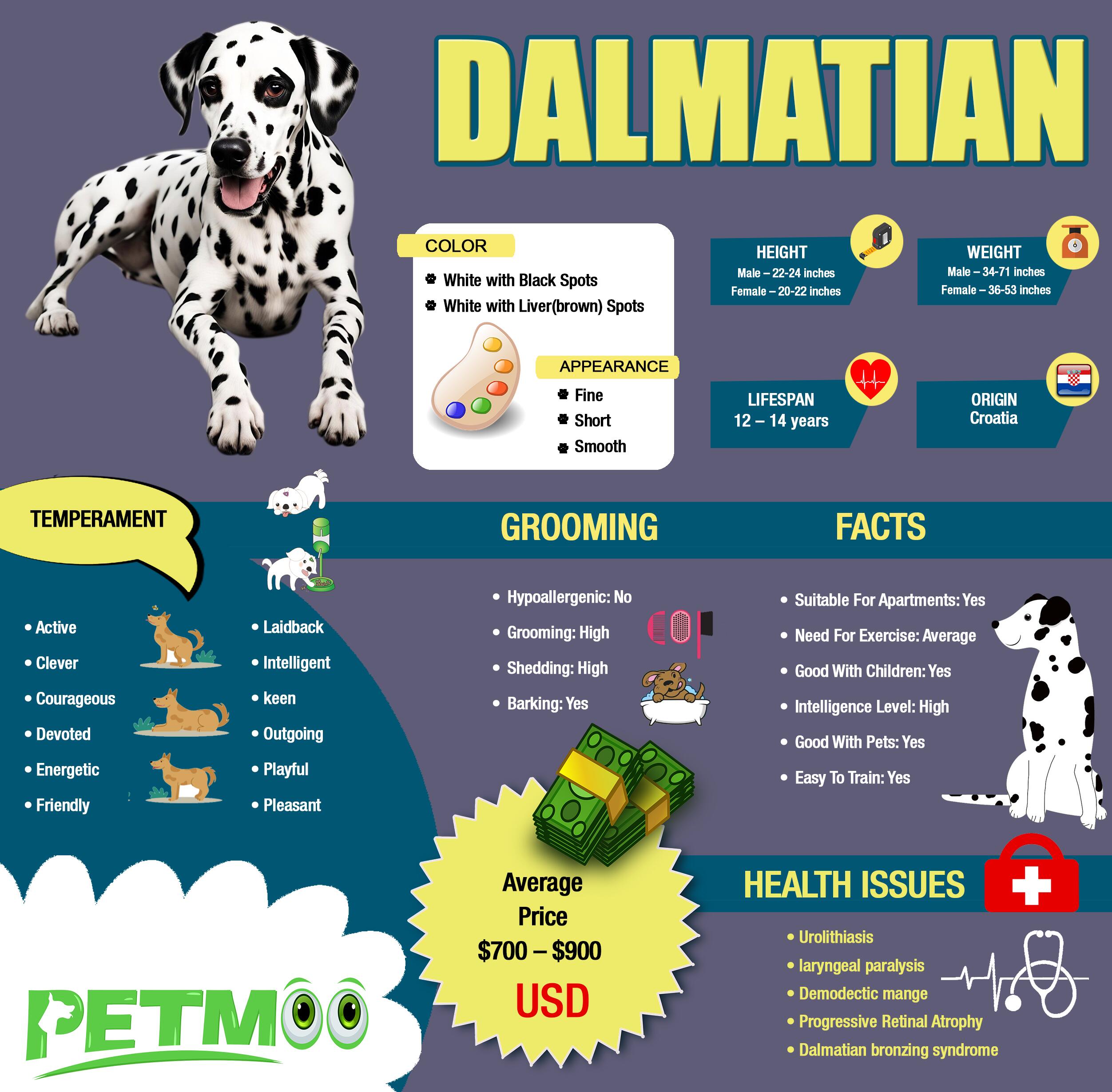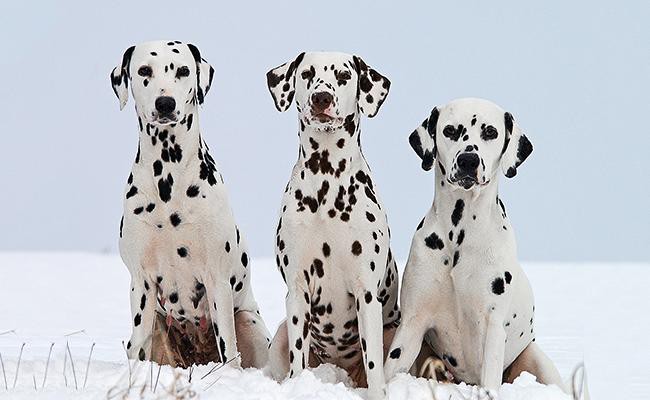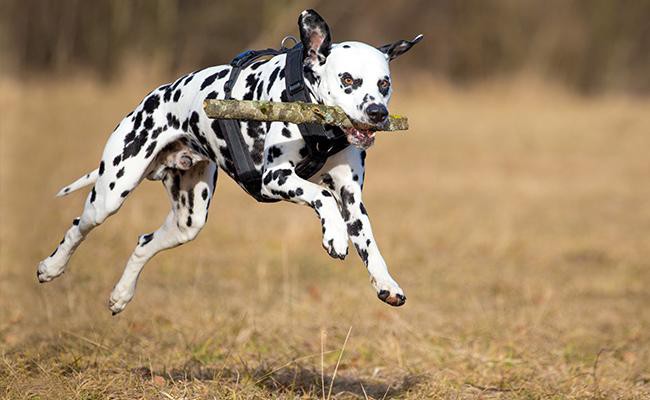Dog Pregnancy Calculator And Timeline
When one thinks of a quirky and unusual looking pet, a Dalmatian comes instantly into the mind. Dalmatians gained popularity after they were featured in the animated and live Disney movies 101 and 102 Dalmatians.
Some of the famous celebrities such as Michael J Fox, Marlon Brando, Melanie Griffith, Gloria Estefan, Yves St. Laurent, Paula Abdul, and Marc Jacobs are the proud owners of Dalmatians.
If you are planning to get a Dalmatian as a family dog or if you are a proud owner of this energetic breed, good for you, you have made an exciting decision.
We bring to you all the aspects that you will have to take into account before getting a Dal so that you are able to offer a pet-friendly home that develops a hale and hearty dog as well as a long lasting companionship.
Now, it time to Meet the Spotted Lovebug.
Dalmatian Breed Characteristics Sheet
- Origin: Croatia
- Size: Large
- Dog Breed Group: Non-sporting/hound/utility/companion breeds
- Purebred: Yes
- Lifespan: 12 – 14 years
- Height: Male – 22-24 inches (55-60 cm),Female – 20-22 inches(51-56 cm)
- Weight: Male – 15-32 kg (34-71 lbs), Female – 16-24 kg (36-53 lbs)
- Coat Appearance: Fine, short, smooth
- Coat Colors: White with Black Spots, White with Liver(brown) Spots
- Temperament: Active, clever, courageous, Devoted, energetic, Friendly, Laidback, Intelligent, keen, Outgoing, playful, pleasant, Responsive, sensitive, spirited
- Good With Children: Yes
- Intelligence Level: High
- Good With Pets: Yes
- Hypoallergenic: No
- Grooming: High
- Shedding: High
- Barking: Yes
- Suitable For Apartments: Yes
- Need For Exercise: Average
- Easy To Train: Yes
- Good For First Time Owners: Yes
- Health Issues: Urolithiasis, Progressive Retinal Atrophy, Demodectic mange, laryngeal paralysis, Dalmatian bronzing syndrome
- Litter Size: 6-18 puppies
- Average Price: $700 – $900 USD, £711 for Kennel Club registered, £590 for a non-kc registered
Dalmatian History
The Dalmatian, or “dal” as his friends call him, these delightful, perky white dogs are one of the well-recognized dogs in the world with its spotted coat and sleek body.
He is not only a firehouse mascot but is also a coach dog.
While running with the carriages on long journeys, the spotted dog protected the horses from other dogs, helping to hold off highwaymen and add a tinge of flair to the carriage with aristocratic passengers (Just like we have cars with racing stripes nowadays).
They were one of the first breeds that Martha Washington, wife of George Washington bred herself.
The delightful Dalmatian has been known by many different nicknames. The breed has been called the Firehouse Dog, Carriage Dog, the English Coach Dog, and the Spotted Coach Dog, among others.
Also humorously called the Plum Pudding Dog, because of his characteristic liver or black colored spots against white were indicative of the traditional spotted desert.
Is Dalmatian, The Right Dog For You?
If you want a dog who…
- Is Quirky looking
- Dependable, dignified gentleman, yet high-spirited and lighthearted
- Has a short easy-to-brush coat
- Is athletic, vigorous dog and has great endurance
- Thrives in interactive family activities
- Is usually polite with everyone
A dal may be right for you. Get your very own celebrity.
If you don’t want to deal with…
- regular exercise requirements
- boisterousness and exuberant jumping, especially not exercised or socialized enough
- Barking and Destructiveness when left alone too much
- shyness or aggression in some lines, or when not socialized enough
- doggedness, requiring a pack leader who can take charge
- High shedding – all through the year
Sorry, a Dal may not be right for you.
Dalmatian Size And Lifespan
Dalmatian Size
Height
Male – 22-24 inches (55-60 cm)
Female – 20-22 inches(51-56 cm)
Weight
Male – 15-32 kg (34-71 lbs)
Female – 16-24 kg (36-53 lbs)
Dalmatian Lifespan
A healthy DAL should expect to enjoy a life expectancy of between 12 – 14 years when properly cared for and fed a good quality diet to suit their ages.
Dalmatian Coat Color And Appearance
Dalmatian Coat Color
Coat Color
The accepted breed standard colors
- White with Black Spots
- White with Liver(brown) Spots
There are several other colors that appear from time to time and there are long-coated Dalmatians as well.
The variations are Golden, orange, blue, pale lemon, tricolor (bi-colored dogs showing the tan-point pattern), brindles (pattern of dark stripes on a fawn background), brindled tricolors, mosaics (liver and orange), two-tone spots (liver and lemon) etc.
There are also phantoms (my own term for an interesting anomaly) with some black-spotted Dalmatians that have areas of brownish hairs, usually on the hock area of the rear legs, on the ears and/or on the insides of the front legs.
Dalmatian Appearance
The Dalmatian should be a well-proportioned (slightly rectangular), distinctively spotted, muscular, active dog of good demeanor. Symmetrical in outline, free from lumber and coarseness, capable of great endurance, clean movement with a fair amount of speed.
- Length of a skull – Length of muzzle = 1:1.
- Length of the body – Height at the withers = roughly 10:9.
Facial Region
Longish, flat, fairly broad skull between the ears, with well-defined temples and exhibit a moderate amount of stop.
Long, powerful muzzle (never snipey) with clean lips and a black nose( for black spotted dogs) although dogs with liver coats have brown noses.
Medium sized round eyes are set moderately well apart, bright and sparkling with an alert expression moderate sized ears are set on rather high and wide at base gradually tapering to the rounded point and carried close to the head.
Lips will be Clean fitting the jaw moderately close, not pendulous. Strong Jaws with perfect and regular scissors bite and has a complete set of 42 teeth.
Body
Their necks are fairly long, nicely arched, clean-cut, tight and entirely free from throatiness. Well-laid Shoulders, moderately oblique which is laid flat against the body.
Level Topline which arches slightly over the loin. Not too wide Chests but very deep and sizeable, moderately well sprung, ribs which are never curved like barrel hoops (which would signify want of speed).
Strong and muscular loins with powerful upper thigh and lower thigh muscles. The tail should reach the hock in length, strong at the placing and progressively taper towards the end.
The tail is not set too low down plus with a slight upward curve but never curled.
Dalmatian Temperament
- With his unique spots and majestic carriage, the Dalmatian is probably one of the most renowned dog breeds on the globe. Several million are attracted to his debonair good looks, but he’s certainly not for everyone.
- While Dalmatians love human company for any activity that occurs in the course of their day and can make fantastic companion dogs, their eager and enthusiasm may be exhausting to live with.
- If you think an energetic personality, distinctive looks, and unwavering loyalty make for a great canine pet, a Dal could be the ideal dog breed for your family.
- Intelligent, intrepid, active, protective, gentle, social, patient, and relatively non-aggressive; these qualities make them generally good with children.
- Dalmatians are, perhaps, most famous as firehouse mascots and, in earlier days, when they used horse-powered fire trucks, employed a few Dalmatians to help relax and control horses which are disinclined to move towards burning buildings.
- This seemed like a perfect combination of brains and brawn. They’ve been used as guard dogs, hunting dogs and retrievers during wartime.
- Being multi-taskers and do them well needs intelligence and dedication which also takes an enthusiastic temperament and a deep-seated desire to please.
- When Dalmatians are improperly socialized or left alone too much, their imposing intelligence can lead to chewing, scratching and digging.
- If they’re confronted with unfamiliar people and haven’t been taught how to behave, their shielding inclinations can result in barking, snapping and even nipping.
- The Dalmatian is one breed that really benefits from patient and persistent training. This breed can rise to nearly any challenge if given care and a loving, warm environment.
- This is one sharp dog that can go from controller to a clown in a split second.
- It is a hilarious dog with a sly sense of humor, that will give you great times. Another important thing is that if he is not given the right amount of mental stimulation and daily exercise, they quickly get bored and they will develop disorderly behavior.
For first time owners
Dalmatians are the best choice for first-time owners because they are really open to learning new things and love nothing more than to please their owners.
These are really smart dogs that love to abide by the rules and are straightforwardly trainable. All they want is to see their owners pleased and happy with something they’ve done. Considering this, Dalmatians make good pets for novice owners.
Adaptability
- Apartment living – Yes
- Good for first-time owners – Good
- Sensitivity level – High
- Loneliness – Hates to be left alone
- Cold weather – Average
- Hot weather – Average
Friendliness
- With Family – High
- Kids – High
- Other dogs – High
- Cats – Good, if raised together
- Other pets – Good, if raised together
- Strangers – Suspicious
General Behavior
- Independence – Fairly independent
- Dominance – Moderate
- Combativeness – Aggressive
- Indoors – Active
- Outdoor – Highly active
- Territorial – Yes
- Easy of transportation – Good
Dalmatian Care
- Exercise needs – Average
- Intensity – High
- Activity level – High
- Exercise requirements – >90 minutes/day
- Rec. walk mileage/ week – 14 miles
- Playfulness – High
- Grooming needs – High
- Tendency to Drool – No
- To Snore – No
- Bark – High
- To Dig – Low
- Social/Attention Needs – High
Dalmatian Food
Dals are energetic and perky dogs. Consider this energy level when determining how many calories your Dog needs, particularly if you are doing any work or training.
It’s a good idea to feed the puppy twice daily, in the morning and in the evening. Try to mix up 50% of the food you received from the breeder (if you got the puppy from them) with 50% of home food.
For 6-12-month-old puppy – you can feed him twice daily with high quality and wholesome food to support muscle development and growth. You can also offer him delicious treats during training e.g., yogurt, cheese, hardboiled egg and Certain Cooked Veggies (sweet potato, zucchini, squash, etc)
Rough Feeding guide for Dalmatians
As a rough guide, recommended daily amount: 1 to 1 1/2 cups of high-quality dry food a day. Feed the puppy with nutritious meals evenly spread out throughout the day.
- Daily cost – $1.50 – $1.90 (average)
- Monthly cost – $40.00 – $52.00
- Pups between eight and 12 weeks old – 3 meals every 24 hours (250g- 320g).
- 3 to 6 months old – 3 meals every 24 hour period (320g-400g)
- Feed puppies 6 months to 1 year – 2 cups of food daily (400g)
- When your dog hits his first birthday, one bowl or two smaller bowls every 24 hours is typically all that’s necessary.
Remember, the feedings depend on puppy’s activity level. Once a puppy is 11 months old they can be fed adult dog food depending on their activity level.
- Dogs weighing-23 kg = 250-320g
- 24 kg =260-350g
- 25 kg = 280-400g
Remember; these feedings depend on your dog’s intake preferences and depending on their energy level and activity.
Grown-up dogs need to be fed a good quality diet that meets all their nutritional requirements while keeping a close eye on a dog’s weight.
Here is a rough feeding guide.
- Protein content should be between 14 – 21%
- Carb content should be 30 to 70%
- Fiber content should be less than 4%
- Fat content should be less than 10%
- Calcium content should be 0.5 – 0.8%
- Phosphorous content should be 0.4 – 0.7%
- Sodium content should be 0.2 – 0.4%
Dalmatian Training
- Trainability – Easy
- Intelligence – High
- Memory – High
- Mouthiness – Low
- Prey drive – High
- Wanderlust potential – High
- There is no one “ideal method” for all dogs, but whatever techniques you prefer, make sure it accounts for the fact that this is highly intelligent, with a little push for independent thinking and greater urge to please the owners/trainers…so make your training interesting to your dog.
- It’s important that their training not to be rushed, but rather broken down into shorter sessions that are fun and to keep your dog focused. Long, droning training sessions do not suit these dogs because they get bored easily.
- The importance of early training and proper socialization is of paramount importance. In the right hands, Dalmatians are a shrewd learner and they thoroughly enjoy the one-to-one connection they have with their trainers or owners.
- They do not respond well to any sort of heavy-handed training or harsh correction methods. However, they do respond well to positive reinforcement in the form of praise or treats which gets the best results from these sensitive, sharp dogs.
- Once the basic training has been finished, Dalmatians will stand out in basic obedience and should be “graduated” into advanced training in tricks, tracking or agility.
Remember, while most of the stronger breeds should be trained “with an iron fist,” the Dalmatian would only ever be trained “in an iron fist with a satin touch.”
This simply means that this breed deserves and demands a deep relationship built on mutual respect as they love pleasing their owners so much.
Dalmatian Shedding And Grooming
Dalmatian Shedding
- Coat density – Normal
- Length – Medium
- Texture – Straight
- Brushing frequency – Daily
- Trimming/stripping – No
- Hypoallergenic – No
- Shedding – High
The characteristic short, glossy coat that covers the Dalmatian dog is amazingly dirt resistant, so these lively dogs need only bathing once in a while, and more regular bathing can promote allergic dermal reactions or dry the skin.
These dogs do shed copiously throughout the year and are not at all hypoallergenic. It is amusingly said among Dalmatian aficionados’ that they only shed two times, once in the morning and again in the evening.
In order to maintain their smooth and elegant appearance, regular brushing is an absolute must.
Dalmatian Grooming
A grooming glove, rubber curry comb, bristle brush or even a pumice stone can be employed to strip out dead fur and prevent the loose and dead hair from being left everywhere around the home.
Dalmatians suffer from skin allergies, so you have to take extra care to maintain their coats in good condition and this includes using a special dog-specific shampoo.
Another important thing is that the ears of a Dalmatian droop low and it is essential to keep them dry and clean to prevent fungal or bacterial infections to develop as an increase of debris or earwax can promote infections to flourish.
Interesting Facts About Dalmatians
- The old breed has taken on a lot of names over the years, including the Carriage Dog, the Fire House Dog, English Coach Dog, the Plum Pudding Dog and the Spotted Dick (that’s also a dessert in England, stop snickering).
- Multitaskers used for many purposes over the years.
- They’re talented sporting dogs and are used as trail hounds, retrievers, watchdogs, boar hunters, ratters, birding dogs, and. Furthermore, thanks to a unique coat and excellent memory, the pooches made good performers in the circus and on the stage.
- While the Dalmatian is not present in the list of “most popular dogs” by AKC registration, but the numbers of adopted Dalmatians increased spectacularly when the book by Dodie Smith, “The Hundred and One Dalmatians” was published in 1956.
- Dalmatian’s popularity continued when Disney released the animated movie version in the ’60s and then as a live action movie in 1996.
- If a Dal seems to be ignoring you, don’t think it is stubborn; it could just be because it can’t hear you. According to the Dalmatian Club of America, up to 12 percent of Dalmatians are deaf and that is one of the largest percentages among all dog breeds.
- Many other dals can hear in only one ear as a result of the improper breeding.
- Dalmatians are distinctive for their piebald pattern. Typically these spots are brown or black, but sometimes they can be blue, lemon, golden or brindle.
- No Dal has same spots, but most have these spotted markings all over their body. Even when you open a Dal’s mouth, you can find spots in their mouth.
- notwithstanding, they are being covered in spots in adulthood, puppies are born snow white. Until about four weeks, Pups generally don’t grow their trademark spots.
- This information might come as a surprise as it directly contradicts what you have seen in the Disney movie 101 Dalmatians.
- Dalmatians have well-proportioned bodies and are very athletic as well as agile. A Dalmatian can run up to 40 mph.
- Dalmatians are also famous as companions to the Budweiser Clydesdales. Dalmatians have been part of the Budweiser Clydesdales’ team since 1950 when Dal was introduced as the Budweiser Clydesdales’ mascot.
- Keeping with the tradition of coach dog, Three Dalmatian travels with each of the Clydesdale hitches (West Coach, East Coast, St. Louis). And they always make the Dalmations sit next to the driver on the wagon.
Dalmatian Health Problems
Certain health diseases are prevalent in Dalmatians.
Urolithiasis – Urolithiasis is a nutritional disease referring to the presence of crystals or stones in the kidneys, bladder or anyplace in the urinary tract
Progressive retinal atrophy (PRA) – Deterioration of the retina which causes progressive vision loss
Allergies – Common allergens consist of dog foods that contain elevated levels of grains and other cereal-type fillers, Dust mites, airborne pollens, Flea, and tick bites
Minor concerns
Demodectic mange – Also known as red mange, follicular mange, puppy mange or demodicosis, this is an inflammatory disease in dogs caused by the tiny, cigar-shaped, eight-legged Demodex mite. This can be a very serious and traumatic skin problem for your Dalmatian.
laryngeal paralysis – This is a congenital disease that causes upper airway obstruction in which the larynx does not open and close properly, making it difficult to breathe or eat
Dalmatian bronzing syndrome – Also known as Dal crud, this is a type of bacterial folliculitis found exclusively in Dalmatians. This is an inflammation of the hair follicles where the affected dogs have a red-brown discoloration of the skin with patchy hair coat and their skin has a brownish-red hue color.
Dalmatian Price And Breeders
Dalmatian Price
Depending on the moral and ethical standards of the breeder as well as the lineage of the parents, vaccination details you can expect to pay an average of $700 – $900 USD for your purebred Dalmatian!
Alternatively, you can adopt at dog rescue centers and animal shelters for around $500. They exist in all the countries and will also have grown-up dogs to re-home.
Dalmatian Breeders
Our 2018 list for the most reputable breeders in America
- Lakeshore Dalmatians Mount Olive, Alabama
- Alpha N Omega Dalmatians East Granby, Connecticut
- Folklore Dalmatians Crown Point, Indiana
- Gaelic Dalmatians Indian Trail, North Carolina
- Dalmatian Plantation Adkins, Texas
- Dorothy’s Perfect Pets Marshall, Texas
- Snow Dalmatians Hawkins, Texas
- Daystar Dalmatian York, Pennsylvania

